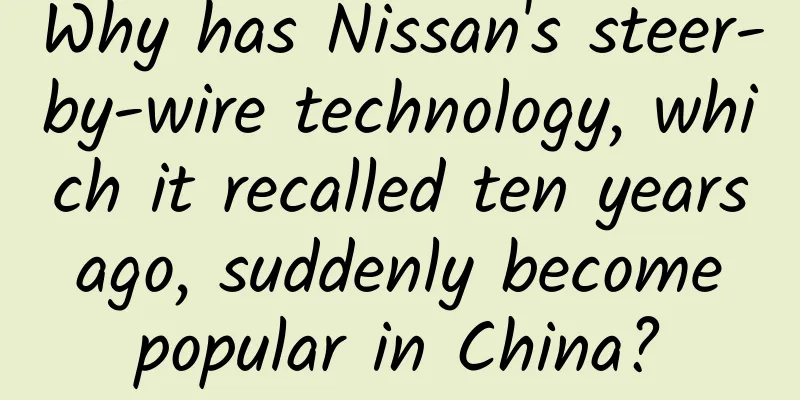Why has Nissan's steer-by-wire technology, which it recalled ten years ago, suddenly become popular in China?

|
Steer-by-wire, which has not been mentioned for a long time, has recently become a hot topic again. Recently, the steer-by-wire technology of NIO ET9 has been approved for mass production by the Ministry of Industry and Information Technology, making it the first mass-produced model in my country equipped with steer-by-wire technology. At the same time, NIO will also participate in the formulation of the national standard for steer-by-wire as a core member unit and the only company with actual mass-produced models. So far, Chinese independent brands have also made their own breakthroughs in the field of wire-controlled steering. When it comes to wire-controlled steering technology, many people have heard of it. In 2021, Musk revealed that Tesla has been developing wire-controlled steering technology and it is likely to be mass-produced in 2023. By 2023, the Cybertruck released by Tesla will be equipped with steer-by-wire technology, eliminating the traditional steering column and using electrical signals to control the motor to complete wheel steering. The so-called steer-by-wire technology removes the traditional mechanical linkage and transfers the vehicle's steering control from human to computer. The driver's steering wheel instructions are completely transmitted to the ECU through electronic signals, and the ECU analyzes the instructions and transmits them to the steering gear to complete the operation. With the help of full electronic control, the steering ratio and driving feel can be flexibly adjusted to adapt to road conditions and the driver's driving habits. It is different from traditional mechanical steering technology in that the steering wheel and front wheels of traditional cars are made of hard steel parts, and the physical structures such as gear shafts and racks are directly connected together. When the steering wheel turns, it directly drives the gear rack, which then directly drives the thick pull rod to forcibly pull the angle of the front wheel, so that the car turns. Steer-by-wire replaces the mechanical connection between the car's steering wheel and steering wheel with electrical signal transmission and control. In other words, there is no mechanical connection between the steering wheel and the front wheels. The principle is that car manufacturers integrate a small motor into the steering structure. When the driver turns the steering wheel, the ECU will perform calculations and send instructions to the small motor. The output torque drives the gear set to work and help the steering arm move to the target position. We can understand its operation process in this way: the user turns the steering wheel, the steering wheel sends a signal to the computer, and after the computer receives the signal, it performs calculations and finally directs the corresponding motor to control the angle of the front wheels, thereby making the vehicle turn. From the principle of wire control steering, its emergence means that physical structures such as gear shafts and racks are no longer necessary, and can even be completely decoupled. When a large number of mechanical parts are eliminated, the relevant costs will naturally be further reduced, and the effect of reducing costs and increasing efficiency will become more obvious. In addition, the reduction of mechanical parts is also more conducive to the layout of the steering wheel for vehicle manufacturers. For example, the shape of the traditional steering wheel can be optimized, and even the size and position can be flexibly arranged. Take Tesla's Cybertruck for example. Traditional steering may require one and a half or two turns to complete a U-turn. However, the Cybertruck equipped with wire-controlled steering technology does not require this. As long as the maximum steering wheel angle is controlled within 180 degrees, the steering operation can be easily completed. It can be seen that the advantages of wire-controlled steering technology are quite obvious. Especially in the era of intelligent electric vehicles, electronic systems will replace mechanical systems, which is the general trend of future industry technology. Naturally, wire-controlled steering technology has become the main direction of competition among various car companies. The State Council issued the "New Energy Vehicle Industry Development Plan (2021-2035)", which clearly proposed to list the chassis integration of pure electric vehicles and wire-controlled execution systems as key technical research projects. The industry's technological development trends, coupled with national support, have further boosted everyone's enthusiasm for the research and development of online steering technology. However, even if this technology is the general direction of future technological development and NIO ET9 has already achieved mass production, it will still be difficult to truly achieve "standard configuration" in the future. Without mechanical steering, the connection between the steering wheel, wheels and the ground becomes weaker. Simply put, the steering wheel is decoupled from the wheel, and the feel of the hand and the road will no longer be obvious, which obviously affects the control experience. To restore the feel of the hand and the road, car companies have to add more sensors and more vibration motors, and debug them in a time-consuming and laborious manner. This investment may not be less than the investment in mechanical steering in the past, and it is hard to say whether it can be "popularized" in future new energy vehicles. In addition, the "safety anxiety" that wire control technology brings to users is also an issue that car companies have to consider. The possibility of electronic system failure is often higher than that of mechanical steering failure. Once the car's intelligent system fails and cannot accurately convey instructions to the car, the vehicle without the traditional mechanical structure will most likely lose control, and the driver will have no way to remedy the failure. As early as 2013, Nissan mass-produced wire-controlled steering on the Infiniti Q50. At that time, the car was equipped with three ECUs to transmit electrical signals, retaining the mechanical structure as a safety redundancy. Unfortunately, less than two years after the car was launched on the market, Infiniti conducted a large-scale recall. The reason for the recall was that in certain extreme cases, the ECU would misjudge the steering wheel angle, causing the actual wheel angle to not match the steering wheel angle, posing a safety hazard. In October 2022, Toyota BZ4X was also equipped with steer-by-wire technology, but due to various reasons such as regulations and costs, this car also did not receive good market feedback. After several years of development, today's wire control technology has certainly evolved compared to the past, but it is still not easy to mass-produce this technology on vehicles. Even though the fault tolerance of vehicle electronic systems can be ensured through multiple redundant designs, the costs involved and the risks that users may have to bear are still unknown. Objectively speaking, the development of wire control technology is helpful to the development of the entire autonomous driving and smart car industry, and it is also an important part of the execution end of smart driving cars. From the demonstration video released by NIO, it can be seen that the NIO ET9 can turn the vehicle around with a slight turn of the steering wheel, and then quickly restore the normal steering ratio. This silky and seamless variable steering ratio capability is not available in mechanical steering. It is worth noting that even if this is a general trend towards technological development in the future, car companies should also pay attention to the risks behind this technology and popularize it to consumers. For example, is this technology easy to adapt to? What is it like to drive? What should I pay attention to... However, at present, there are many manufacturers who are cheering for the wire control technology, but it seems that no one has popularized the precautions related to the wire control technology. As a winner of Toutiao's Qingyun Plan and Baijiahao's Bai+ Plan, the 2019 Baidu Digital Author of the Year, the Baijiahao's Most Popular Author in the Technology Field, the 2019 Sogou Technology and Culture Author, and the 2021 Baijiahao Quarterly Influential Creator, he has won many awards, including the 2013 Sohu Best Industry Media Person, the 2015 China New Media Entrepreneurship Competition Beijing Third Place, the 2015 Guangmang Experience Award, the 2015 China New Media Entrepreneurship Competition Finals Third Place, and the 2018 Baidu Dynamic Annual Powerful Celebrity. |
>>: What hacking technology was used in the self-driving car in "Fast and Furious 8"?
Recommend
Is the solar system dark? Scientists have just discovered three "planet killers," one of which poses the greatest threat to Earth
Astronomers have discovered three near-Earth aste...
Electric Technology Car News: Changan Oushang vs. Baojun 730: How to choose an independent MPV
In recent years, with the launch of family MPVs b...
NetEase Cloud Music Product Analysis
1. Introduction After analyzing the iterations of...
9 Things Cancer Cells Fear the Most, Be Sure to Do Them More Often! Save Them Now
When it comes to cancer, many people are frighten...
Popular Science | Answers to common questions about orthokeratology lenses
Recently, many parents and friends have come to o...
How to create tens of millions of daily active users? Share 7 major operation strategies!
When judging whether a product is well made, the ...
Foxconn reveals the inside story of iPhone recycling market
The main business of the new company, Aifengpai, ...
Beware! A pen contains ten kinds of poisons. Your children may also be using it...
This article was reviewed by Chu Yuhao, PhD from ...
Why is live streaming app development so popular?
Nowadays, the development of various mass communi...
up to date! Traffic rankings of 45 information flow platforms across the entire network!
The latest traffic rankings of major information ...
Guided by the "hot product methodology", iCAR's brand upgrade is "quite interesting"
Today's new energy vehicle sector seems to be...
Is Baidu Youqianhua legitimate? Will the loan affect the mortgage in the future?
Young people nowadays have developed the concept ...
How to write original content? 6 tips for finding topics!
Many website editors have this worry: after a lon...
Folding phones need to make these five changes to be accepted by the public
As we all know, the global smartphone market has ...
Four marketing techniques for jewelry industry on Xiaohongshu
Some time ago, a friend of mine on Xiaohongshu to...









